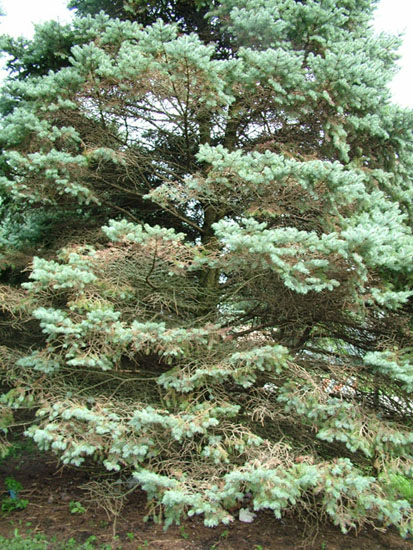Issue 11, July 2, 2010
Spruce Rhizosphaera Vs. Cytospora
Rhizosphaera needle cast has been a common Plant Clinic sample in the last two weeks. Spruce trees with purple/brown one- and two-year-old needles are suspect. The newest growth will appear green. Affected needles are cast (dropped). Since evergreens do not re-foliate along the branches, the disease will cause bare areas scattered throughout the tree if untreated. Norway spruces are considered resistant to this needle cast while Colorado blue spruce is a common host.
The image shows a spruce tree with a severe Rhizosphaera needle cast infection. Notice that the tips of all branches are still green while older needles are affected. There is a fairly simple test you can try on your own to confirm the presence of the causal fungus. This fungus will form fruiting bodies that are black and about the size of a pinhead. In humid conditions the fruiting bodies will emerge through the stomates on the needle, appearing in neat rows down the needles. It helps to incubate suspicious needles overnight in a plastic bag with a moist paper towel. Then observe the needles for fruiting bodies. A hand lens is helpful but not necessary.

The only other disease we see regularly on spruce in Illinois is Cytospora canker. That disease causes entire branches to turn purple/brown. Cytospora affects all needles from the tip of the branch to the base. Often lower branches are affected first, as in the image. The disease may progress up the tree slowly, killing branches over a number of years. Cytospora (aka Leucostoma) canker will occur on young trees, but it is more common on trees at least 15 years old. On spruce there is usually a sappy exudate associated with the canker, but this sap is a thin layer, not the large blobs of sap associated with some insect pests such as pine bark and pitch moths. The wood under the bark of a tree with Cytospora canker is brown (dead) rather than green or white. The fungus is known as a stress pathogen, meaning it invades spruce trees growing in less than ideal sites or environmental conditions.

If Rhizosphaera needle cast is diagnosed, get a good look at the affected tree. Often Cytospora canker and Rhizosphaera needle cast appear on the same tree. Assess the big picture so that you can manage the problem correctly. A University of Illinois disease report, Cytospora or Leucostoma Canker of Spruce, RPD No. 604, is available on the Internet.--Nancy Pataky
Author:
Nancy Pataky